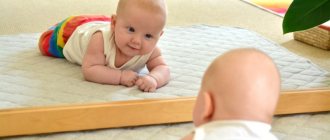Of course, all parents today have heard about the benefits and importance of crawling. After all, it is precisely this skill that contributes to the most complete and harmonious development of the child and even makes life somewhat easier for parents. After all, it is crawling that allows the baby to most actively explore the entire world around him, reaching out to all objects that are attractive to him.
But sometimes it happens that a child of 8 months does not crawl on all fours, although many children begin to do this as early as six months. Other children, as soon as they begin to sit, try to get up and walk. Therefore, if a child is not crawling at 8 months, then it is not at all surprising that parents are quite worried about this. True, if neither a pediatrician, nor a neurologist, nor an orthopedist sees any reason for concern, it means that the development of a particular child is absolutely normal.
What gives a child the skill of sitting?
To appreciate the importance of this process, you need to understand the following. A child who spends most of his time lying down suddenly realizes that an unknown world extends around him.
At the same time, the baby’s hands, when he is sitting, allow him to take the toy, feel it and put it in his mouth. He can easily play alone when he is in this position. Parents will feel a real sense of relief when their baby can entertain himself for some time.
Sitting prepares the child's back for walking. This is its benefit and harm, because the standing position increases the load on the spine. Sitting, on the contrary, strengthens the muscles, making them ready for the first steps.
That's why it's so important not to rush things. And it is best to prepare the spine for increasing loads, i.e. crawling. After all, this is one of the most important skills for a child.
How to teach a baby to crawl at 8 months? Every child is different, so not everyone starts performing these movements at the same time. Further in the article the features of this process will be discussed.
How to teach a 6-8 month old child to crawl on all fours?
Crawling is an acquired reflex that every baby masters sooner or later. This happens at about six months, and before that the child will have to learn to turn on his side, back and tummy, hold his head up and sit.
Alas, the period of learning to crawl is not always cloudless. This is a very difficult process for the baby, so at such moments parents should always be with him and help. To do this, you need to know how to teach your child to crawl correctly and quickly after he reaches 6 months, what activities to do with him, and how often you need to exercise.
When do babies start crawling?
Child psychologists and pediatricians consider the question of when a child should learn to crawl to be incorrect. This is purely individual; no specialist can give the most accurate answer.
Of course, there are generally accepted boundaries, boundaries of childhood, when babies should gradually show interest in moving around by crawling. But they are average, so it’s not worth “driving” the baby into them. And even more so, one should not assume that it is developing too slowly - everything has its time!
It is also worth considering that girls, developing faster than boys, begin to learn to crawl earlier. This process is easier for them, even more fun and active.
Heredity is of no small importance in this matter. If one of the parents began to make the first crawls late, it means that the baby may well take over this trait from mom or dad. You can help him cope with learning much faster if you study with him for at least 10-15 minutes a day.
The benefits of moving on your bellies and on all fours
Moving on your belly or on all fours is equally beneficial for your baby. First of all, because:
- The musculoskeletal system is strengthened. If you regularly give your child space for such “races,” then over time it will be possible to get rid of some defects and violations on the part of the ODA. First of all, this concerns torticollis, muscle hyper- or hypotonicity.
- The child’s spine is strengthened, and physiological curves of the spine are formed.
This is extremely important so that the child can subsequently sit, walk, and engage in physical activity normally. - Coordination of movements is regulated. The baby begins to gradually master the peculiarities of orientation in space, understands where he needs to move, and also studies how objects are arranged in the house, which is also important.
- Independence develops. While crawling, the baby studies in detail everything that is around him. Subsequently, when he learns to walk, he will easily navigate the space around him and independently reach the place of interest in the house.
While crawling, the baby subconsciously develops his intelligence. With such movements, the activity of the cerebral cortex increases, and speech motor skills develop and improve.
Physiological readiness of the baby, and how to teach a child to crawl at an early age
It is very important to pay attention to whether the child is physiologically and psychologically ready for such an important stage as learning to crawl. This depends on the age of the baby, which must be taken into account by the parents of the baby.
At 5 months
This period is accompanied by increased activity of the baby's movements. To prepare him for crawling, you need to practice turning him on his side as often as possible, drawing his attention to a toy or other interesting objects.
At 6 months
Babies at 6 months, as a rule, are already actively learning to turn on their side, or even on their tummy and back. It is still difficult for them to sit, so parents must maintain the baby’s balance by holding his back with his hands. In order for the baby to sit, he needs to be covered with pillows on his back and sides.
Classes should be conducted in a playful way. To interest the baby, you can use a gymnastic ball - a fitball.
At 7 months
Children as young as 7 months show particular interest in crawling. They can move on their tummy, on their bellies or on all fours.
If the baby cannot cope with the last stage, then the mother should help him with this. To make a baby crawl on all fours, you need to build a small tunnel or barrier. Thus, the baby will have no choice but to overcome the sudden obstacle.
At 8 months
At 8 months, babies are already crawling at full speed, and are also trying to stand on their feet. First, with the help of mom or dad, or by holding onto a strong support, and then on your own. The mother should give the baby more space for activity so that he has somewhere to walk.
You can carry out such exercises in the fresh air by laying out a soft blanket or blanket for the child. At the same time, the mother should always be nearby, support the baby, guide him, coordinate his movements, if necessary.
You need to work with your baby regularly. At first, you should do the exercises 2-3 times a week. Gradually you need to teach him to do this every day. 10-15 minutes will be enough, however, you need to proceed from the desires of the baby himself.
Practical tips on how to teach a child to crawl on all fours at 6-7 months
There are several effective ways in which you can teach your baby to crawl on all fours.
But before starting classes, it is recommended to undergo a preventive examination by a neurologist and orthopedist. This is especially important for babies who have significant problems crawling.
Preventive massage
Home massage includes:
- crossing the baby's arms at chest levels;
- flexion-extension of the legs;
- turning the baby from the tummy to the back or vice versa several times in a row;
- stroking, rubbing, patting, pinching the back, buttocks;
- stroking the tummy, especially in the navel area;
- raising straight legs up.
If parents are still afraid to conduct such massage sessions, then a professional massage therapist will come to their aid.
Joint crawling
Source: https://kaknazvat.com/deti/nauchit-rebenka-polzat-na-chetverenkax/
What time does a baby start crawling?
Crawling is an important process that occurs in the development of a baby. The child will then be able to move independently and explore the world. Usually, starting from the age of 5 months, parents begin to expect him to develop this skill.
If a child is not crawling even at 8 months, then there is nothing dangerous about it. Previously, pediatricians argued that this should happen at 6 months, but now they are not so categorical about this. The child will crawl when the time comes.
Every child is different, but it is most likely that they will start crawling at 6-8 months. During this period, they begin to be interested in what is happening around them. And when there is the necessary motivation for this, they begin to move in the right direction.
What to do
How much should a baby weigh at 8 months?
The most important thing in this case is to eliminate the obstacle that prevents the development of this skill:
- More freedom. The child needs comfortable clothes, a free floor and a minimum of restrictions. It is better to completely remove jumpers and walkers from use or leave them, but for short periods of time and infrequently.
The baby crawls freely
- Interest. Children should be intrigued by what is located at a distance from them.
- Parental control. The baby is not allowed to sleep on his stomach, but when awake, he should lie like this. To avoid the fear of ADHD, parents need to keep an eye on him during this time.
- Medical supervision. It is unacceptable to avoid routine visits to the doctor. If the baby has problems, the doctor will detect them in the very beginning, which will make the task of eliminating them easier. Such a specialist will tell you how to strengthen your immune system.
- Proper nutrition. Food should be healthy, its portions should be in accordance with needs and age.
Also, regardless of the activity of the babies, they are prescribed restorative massages. Moreover, the superficial one should be carried out by parents every day, the deeper one is done by a massage therapist, at least a couple of courses are recommended in the first year.
When baby starts sitting
There are several developmental stages in a child's development. Among them is sitting. Usually parents really look forward to this moment and sometimes make a number of mistakes. Approximately, children begin to sit at 6 months, and without outside help at 8. The timing may shift, depending on psycho-emotional and physical development.
The main condition is that the child should not be seated prematurely. Sometimes parents, seeing how he pulls himself up at 4-5 months, think that he is ready for this stage of development. In fact, babies are exercising their muscles. Therefore, you should not lift him more than he does on his own.
Another mistake mothers and fathers make is to sit the baby down on their own or cover him with pillows. This could cause him serious injury. You need to wait until the baby does this on his own.
The ability to sit depends on the strength of the muscles, so large or thin children will be able to master this skill by 8-9 months. To speed up the process, you can do special gymnastics and massage.
When do babies start crawling?
Child psychologists and pediatricians consider the question of when a child should learn to crawl to be incorrect. This is purely individual; no specialist can give the most accurate answer.
Of course, there are generally accepted boundaries, boundaries of childhood, when babies should gradually show interest in moving around by crawling. But they are average, so it’s not worth “driving” the baby into them. And even more so, one should not assume that it is developing too slowly - everything has its time!
On a note!
Many children begin to crawl at the age of 5-6 months. Other babies master this process at 7-9 months of age. This is absolutely normal, so this situation does not require medical intervention.
It is also worth considering that girls, developing faster than boys, begin to learn to crawl earlier. This process is easier for them, even more fun and active.
Heredity is of no small importance in this matter. If one of the parents began to make the first crawls late, it means that the baby may well take over this trait from mom or dad. You can help him cope with learning much faster if you study with him for at least 10-15 minutes a day.
Should parents worry?
If at 8 months a child sits without outside support, then he is developing correctly. After all, everyone has their own development schedule. Why doesn't a baby crawl at 8 months? Perhaps his time has not yet come. Although, when this happens, it brings a lot of joy to parents.
If the baby is not crawling yet, the mother can consult a pediatrician, orthopedist or neurologist. If they do not find any deviations in the child’s development, then, most likely, he will immediately begin to master walking skills. And therefore, the missed stage of crawling will take place along with the first steps. If the baby was born premature, then it is quite possible that his development process will shift. And he will crawl closer to 10-11 months.
How to prepare your baby
How to teach a baby to crawl at 8 months? A baby has a constant desire to move from the first days of his life. It is connected with his desire to actively explore the world. Parents should encourage this in every possible way. This does not require special knowledge or effort.
You can stimulate activity in the following ways:
- By 3 months the baby should be able to hold his head up. If it is difficult for him to do this, then for training he is laid out on his tummy. Laying out the toys will encourage him to turn his head to look at them. Wellness massage also helps strengthen muscles.
- At 4 months he can be taught to grasp various objects and his legs. And when he pulls his limbs into his mouth, the muscles will stretch. At this age, the baby cannot yet sit, but games will help develop this skill.
- By 6 months, the child should turn on his side. You can help him in the following way. Mom bends her leg at the knee and moves it slightly to the side. And the child himself will complete this action.
If the baby is not yet sitting at 6 months, then you should try to strengthen the skill of turning in different directions. This helps strengthen the muscular system. But you should not force a fragile child to sit, as this can lead to health problems. You don't need to pull his arms to make him sit.
How to teach a child to crawl? All about the benefits of this skill and exercises for training it
The child is growing, and parents are happy to watch his transformation and are proud of his new skills. However, if they notice that the baby is lagging behind the children they know, they get a little upset. One of these skills is crawling. Some children begin to crawl on their bellies and do not want to get down on all fours.
Mothers wonder: how to teach a baby to crawl on all fours? But it happens that a child skips this stage altogether and starts straight away with walking. When asked whether crawling is necessary for a baby, doctors say yes.
When babies start crawling
Motor development skills such as the ability to hold up one's head, sit up, crawl, stand up and walk in children appear at different times. There are average age standards for the development of these skills.
But deviation from these standards does not mean that the child is behind in development, he just has this variant of the norm.
Diseases that impair motor development are very rare, so most children go through all stages of development, including crawling.
Even when a child is three months old, laying him on his tummy, you can notice that he is trying to crawl on his stomach. Some children can already stand on all fours at 4-5 months, and at six months they begin to actively crawl. Others make their first attempts as early as 8-9 months.
Pediatricians believe that the average time for a baby to start crawling is 6-10 months.
Large children, as a rule, move less actively, and they also develop this skill somewhat later than their peers. And if it comes to a premature baby, then its development standards shift even more.
Therefore, such a baby may well begin to crawl at 10-11 months, even if he was born 2 months premature.
About the benefits of crawling. should this be taught?
It happens that a child skips the crawling stage. He learns to roll over on his tummy, sit down, stand up, and then immediately walk. Parents are proud that their child is so skillful, he started immediately, and even earlier than others. But is this good for the baby? Experts are sure no.
The ability to crawl should not be underestimated for a child's health. This skill helps the baby form a muscular corset of the back, strengthen arms and legs, and develop coordination of movement.
All this will help the baby walk correctly in the future and relieve the baby’s fragile spine from untimely increased loads.
Therefore, you should not rush your child to walk; it is better to guide him to the right stage of development, helping him learn to crawl.
Conditions for skill development
If parents want to teach their baby to crawl, then they can help him by creating suitable conditions for the development of this skill.
- First of all, the child will need room to move.
The best solution for this is flooring. In a playpen or other confined space, the baby has no incentive to crawl. Therefore, you need to lower the baby to the floor, having previously prepared him and removed dangerous objects away.
- The surface for learning must be hard and tough.
This could be a special rug, a hard blanket, etc. You should not put your baby on slippery parquet or linoleum. The bed is also unlikely to be suitable - it is too high. You should also not use inclined planes.
- It is necessary to lure the baby and stimulate his physical activity.
The “bait” can be a favorite toy, a new interesting object, a domestic cat or dog. In general, it is good to surround your child with interesting things to attract his attention.
- You can place small obstacles in the form of a twisted blanket and other things along the path of the crumbs.
This will force the baby to raise his body if he crawls on his belly.
- Another way to teach a little explorer is to place him in an environment of the same crawling children.
This could be an early development center or just invite friends with kids to visit. And perhaps soon you will be able to take part in such a championship:
Readiness to crawl at different ages
Often parents begin to worry that their baby is not crawling at 5,6,7 months. This is especially frustrating if familiar peers have already mastered the skill. Don't rush your baby. He is probably already trying to do this, but we need to create the appropriate conditions for him, help him master preparatory skills, strengthen his body muscles, and then he can handle it on his own.
At 5 months, the child tries to roll over on his tummy and crawl. Sometimes it happens that you crawl first backwards and then forwards.
If your baby crawls on his stomach, you can help him learn to get up on all fours.
If the child has not learned to roll over onto his tummy, you must first help him master this skill.
Turn the baby onto his side and lure him with toys so that he turns over on his own, reaching for them.
At 6 months, the baby will already have mastered the tummy roll. We continue to teach him to roll over from his tummy to his back, get on all fours, lift his torso from the “lying on his stomach” position, and reach for toys. To strengthen the muscles of the back, abs, arms and legs, perform special gymnastics, perhaps on a fitball. Massage and swimming will help.
By 7 or 8 months, children most often begin to try to crawl on their own. Sometimes, before learning to move on all fours, babies go through the following stages:
- Pulling themselves up only with their hands, they crawl on their stomachs;
- They crawl on their bellies, working with their arms and legs, but without lifting their stomach from the floor;
- It happens that the baby raises his butt and crawls on straightened legs;
- They crawl on all fours.
At 8-9 months, children usually have already learned to crawl, begin to stand up against a support, and can sit up on their own. Sometimes a child learns to crawl after he has learned to stand up and sit down. After this, it is easier for him to get on all fours.
If by 10 months the baby is not crawling, sitting down or trying to stand up, you should consult a doctor.
How to teach to crawl
It makes sense to teach a child if he is more than 7-8 months old, but he is too lazy to crawl or is not physically developed enough. Then there is a need to help him with massage and special exercises. However, if the baby is not even six months old, and the parents really want him to crawl, then there is no need for training, just create the conditions for mastering this skill and be patient.
If you are sure that the child is healthy, he does not have impaired tone in the muscles of the arms or legs, diseases of the musculoskeletal system or neurological nature, then you can help the baby develop this skill using the following exercises:
Exercise 1. Position the child lying on his stomach. The baby leans on his arms and lifts his torso. Place a cushion under the chest so that the child holds the body, leaning on the cushion. We show the baby toys, raising them just above his head. This will help strengthen the muscles of the neck and shoulder girdle and develop coordination of movement. We gradually move the toys, the child must follow them.
Exercise 2. “Car”. We learn to rearrange our hands. The child lies on his stomach, leaning with his hands, lifts the upper part of the body. We lift his legs and support him under his chest. The handles are in the same position, resting on a hard surface. We guide the baby so that he walks, rearranging his arms. You can put a toy at a distance and let him reach it.
Exercise 3. “Frog”. The child lies on his stomach. Relies on the handles. The mother bends the baby's legs into a frog position and allows the baby to push off, straightening his legs. Repeat several times.
This exercise will also be useful if the baby has learned to crawl backwards rather than forwards. In this case, it is useful to periodically let him push off from your hand, remembering the correct direction - forward.
Exercise 4. Learning to stand on all fours. Place a small pillow or cushion under your chest and stomach. The baby stands on all fours. Fix this position for a while.
Exercise 5. Put the baby on all fours. One assistant holds the baby in this position, supporting him up to his tummy. You can slip a cloth or diaper under the chest and hang the baby, as it were. The second adult moves the child's hand and then his leg in turn, showing how to crawl. You can crawl with your child to make it more interesting and clearer to him what to do.
All these exercises are aimed at strengthening the baby’s muscles and improving coordination of movements. If you do them regularly, you can teach your baby the necessary skill. They need to be performed when the child is in a good mood, remain calm and friendly, so that the activities bring only positive emotions.
You can see examples of other exercises in the video:
Security measures
In order for classes to go smoothly, you need to take precautions in advance:
- Protect the child from collisions with corners, cabinet doors, remove tablecloths from tables so that the child does not pull anything off the table onto himself. Block access to the stairs.
- Ensure normal room temperature so that it is neither cold nor hot.
- Clothes should be comfortable.
- It is better to study on the floor, but if this is not possible, then make sure that the baby does not fall from a height.
- There should be no electrical wires, sockets, or electrical appliances within the child’s reach.
- Remove household chemicals, cosmetics, gadgets, medicines, and pet toilets from reach. Children learn to crawl very quickly, and parents do not always get used to this new routine, so it is better to worry about the child’s safety in advance.
Doctor Komarovsky's opinion
A well-known pediatrician claims that you should not rush your child and you need to give him time to master all the skills on his own. Each child has his own rhythm of development, and there is no need to adjust it. At the same time, the doctor notes the great benefits of crawling. He says that the later the baby starts walking upright, the healthier his spine will be.
However, the doctor does not call for letting everything take its course. In the book “The Health of the Child and the Common Sense of His Relatives” he notes:
Thus, the child should be allowed to develop independently, but massage, gymnastics, hardening and the correct lifestyle provided by the parents will help the baby overcome all difficulties and learn to crawl, stand up, walk and everything else.
You will learn more about the doctor’s opinion about this skill from the video:
Source: https://umnyash.com/rebenok-do-goda/navyki-sposobnosti/kak-nauchit-rebenka-polzat-na-chetverenkax.html
How not to miss the right moment
If a child at 8.5 months does not crawl, but in addition does not sit, then this is a reason for parents to consult a specialist. If he is completely healthy, then mom should not worry. When he learns to sit, you can help him crawl:
- His toys should be placed at some distance from him. For the most successful moments, parents should secure and place the brightest objects even further away. It is necessary to stimulate movements with the help of the games “ladki” or “stomp”.
- If a child is sitting on all fours and trying to get the right toy, then he should not be rushed. It is best to secure this position. Within a few weeks the baby will be able to move around in this position. You can stimulate him by telling him rhymes or nursery rhymes.
- Babies love to crawl from mom to dad and back. You can turn the process into an exciting game.
- You should not force your child to crawl according to your own rules. Let him do it the way he is comfortable: on his face, on all fours or on his butt. If the baby is so comfortable, then you should accept this as an axiom.
- 8 months is the period when he happily begins to communicate with other children. He is ripe for this dialogue.
- If a child of 8 months does not crawl on all fours, then you can invite a family with a baby who has already learned to do this. And organize a fun competition. This will encourage the baby to crawl.
- To make learning more effective, you need to make a small slide for him to slide down. And at a distance from her, parents can lay out their favorite toys.
Refusal of physical activity or crying while crawling or sitting should cause the mother to be especially wary.
An 8-month-old child: why he doesn’t want to crawl and sit on his own, reasons
The life of a young mother is full of worries and worries, especially when it comes to her first-born.
Much is clear only theoretically: how to feed a child, how to dress, bathe. Parents are also concerned about whether their babies are developing correctly. For example, if a child does not crawl at 8 months, is this normal or a deviation? Crawling baby
Baby doesn't crawl, when to worry
Doctors have derived certain average norms for the development of children. Judging by them, all toddlers between the ages of six and eight months learn to move in space independently by crawling.
When calculating the average denominator, it is impossible to take into account factors of individual development. One independent baby gets bored of lying still, so he sits up at 5 months, and by 7-8 months he gets up on his feet. The other, on the contrary, is more phlegmatic: he learns to move more slowly and skips the crawling stage altogether. This may be the norm, according to many famous pediatricians, such as Komarovsky.
Famous doctor Komarovsky
If by eight months the child does not feel like crawling, an adult does not need to sound the alarm immediately. The first step is to make an appointment with a doctor. If he doesn’t find any problems, then you just need to wait patiently, giving the little one maximum freedom.
You should be worried if a child at 8 months does not sit or crawl, and does not make any attempts to do so. This is how existing deviations appear. Such a child should be examined by a doctor, recommend sports exercises appropriate for age, prescribe special procedures, and, if necessary, prescribe a set of medications.
Important! There is no need to rush the development of the baby if he is healthy. It is better to let the baby develop at his own pace, without comparing with others.
Why crawling is important
The child does not sit at 9 months
Crawling is incredibly beneficial. It is this simple movement that develops many systems of the child’s body:
- Firstly, crawling perfectly strengthens the child’s musculoskeletal system. In fact, the little one works dumbbells for himself.
- Secondly, crawling develops binocular vision. The baby learns to catch one object with both eyes. This will be useful for mastering reading and writing.
- The baby is also developing psycho-emotionally. He tries to set a goal for himself, is happy when he achieves it, or sad when he fails. In any case, the little one learns to feel and understand himself.
- Crawling develops the brain. While moving in this way, the connection between the hemispheres of the brain is strengthened, which helps the child learn speech faster.
If it doesn't crawl
Pediatricians say: “The child may not crawl.” But this action is useful. Will children who do not crawl really lag behind in development? Of course, this will affect development, but parents and their child will still have a chance to catch up. This will require more time and effort, but is not a reason for sad thoughts.
Not crawling does not mean lagging behind
Why doesn't the baby crawl?
The child does not sit at 8 months
The range of reasons why a child does not crawl or sit down is quite large. It is important to study them all in more detail:
- Fear. At the end of the last century, doctors covered the topic of sudden infant death syndrome. They all urged not to put babies to sleep on their stomachs. Moms went further by reducing the time they spent on tummy time and outside of sleep. The vast majority of babies began to crawl later. But the infant mortality rate from ADHD has also dropped by half.
- New items of our time. Parents often do not have time to follow their crawling child all day long and keep an eye on it. This also includes parental laziness, because it is much easier to put a child in jumpers or walkers. Crawling – what can it give? Many adults think this way and are mistaken.
Walkers
- Health. There are serious problems that require special monitoring and treatment by a neurologist: hypo- and hypertonicity of muscles, consequences of birth injuries. Relatively simple acute respiratory viral infections prevent the child from studying - he is weakened and feels unwell.
- Weight. It's more difficult for chubby kids to move around, that's a fact.
- Character. Cholerics and sanguine people live on the move. Phlegmatic and melancholic people are calmer. Why crawl somewhere if it’s interesting here too?
Attention! If a child is 8 months old, he does not try to sit and does not want to crawl, in general he is for some reason inactive, and adults have given him relative freedom of movement (for example, within the same apartment), there is only one way out - to visit a doctor. There is no need to self-medicate.
What to do
How much should a baby weigh at 8 months?
The most important thing in this case is to eliminate the obstacle that prevents the development of this skill:
- More freedom. The child needs comfortable clothes, a free floor and a minimum of restrictions. It is better to completely remove jumpers and walkers from use or leave them, but for short periods of time and infrequently.
The baby crawls freely
- Interest. Children should be intrigued by what is located at a distance from them.
- Parental control. The baby is not allowed to sleep on his stomach, but when awake, he should lie like this. To avoid the fear of ADHD, parents need to keep an eye on him during this time.
- Medical supervision. It is unacceptable to avoid routine visits to the doctor. If the baby has problems, the doctor will detect them in the very beginning, which will make the task of eliminating them easier. Such a specialist will tell you how to strengthen your immune system.
- Proper nutrition. Food should be healthy, its portions should be in accordance with needs and age.
Also, regardless of the activity of the babies, they are prescribed restorative massages. Moreover, the superficial one should be carried out by parents every day, the deeper one is done by a massage therapist, at least a couple of courses are recommended in the first year.
How to teach a baby to crawl
It is impossible to say that there is a method that teaches a baby to crawl in the same way as to count and write. There is no such thing. There are some general recommendations on how to encourage little boys and girls to move like this.
On the stomach
- The first crawl (on your stomach or on your belly) can be mastered using the Doman track, Komarovsky believes. This is such a narrow gutter, upholstered in fabric. It is difficult to push off from the floor, but it is much easier if small walls help with this. You can practice this track from 2 months of age.
Domana Track
- If there is no track, you can do without it. Then a toy is placed in front of the toddler as a stimulus. At this time, the adult places his palms under the baby’s heels. He will push off from them and move towards the goal.
On knees
When a child crawls on all fours, he usually uses one side of his body to maintain balance and the other to actually move. This movement is called cross crawl. Parents can tell you how to implement it:
- You can roll a towel or blanket into a roll that is placed under the baby's chest. This strengthens the neck and back. After a little while, you can begin to tuck the baby’s knees under the tummy.
- When both parents gather around the child, they can jointly teach the baby to crawl. Supporting the baby, they put him on his knees, help him rest his arms, then one adult moves the children's arms, the second moves the legs. You need to take your time when performing such an exercise and under no circumstances stop supporting the child.
Important! You need to “teach” to crawl by example. Moreover, it usually works better if dad demonstrates it. Once on the floor, the adult at the same time gets the opportunity to detect all possible dangers from a child's height.
Baby crawling with dad
No crawling threat
Crawling is not a necessary stage of development, like, for example, holding your head. But it is incredibly useful, it is better not to miss it. It is this action that strengthens the muscles around the spine like nothing else.
If the baby quickly gets to his feet, not wanting to crawl, you cannot hold him by force.
Then you need to start an additional course of professional massage, go to the pool with your toddler, and do infant gymnastics more often.
The best option would be to start helping him crawl, showing an example before he even tries to roll over onto his side, especially before he tries to sit down or stand on his feet.
Crawled, sat down, stood up - the ideal development of a baby
Summarizing all of the above, it can be noted that you should not give up crawling on your own. Parents must understand that they are responsible for the health of their baby. First of all, do not what is convenient for them, but what is best for a small defenseless person. Doctors will help them with this, and they should not avoid visiting them.
Source: https://kpoxa.info/uxod-razvitie/rebenok-ne-polzaet-8-mesyacev.html
Opinion of a famous pediatrician
If a child is not crawling by 8 months, Komarovsky is confident that there are not many serious disorders in which he will not be able to learn to sit or walk. They are found quite rarely in medical practice.
Children themselves do not know anything about when they need to crawl. With normal physical development, a small person can sit, stand, crawl and walk without the help of parents. But only he must want it himself.
The parents' task in this case comes down to allowing the baby to develop normally. And don’t turn learning new skills into hard work for the baby. This may backfire and cause him to stop crawling. But parents should help.
According to Komarovsky, hardening and exercises for muscle development should begin at an early age. The procedures will strengthen the body and allow you to quickly master the skills necessary for the first steps.
The pediatrician believes that if a child does not crawl or sit at 8 months, this happens for the following reasons:
- the baby’s muscles are not strong enough;
- he is not emotionally ready for the next stage of development;
- it is difficult for the baby to make unnecessary movements due to excess weight;
- family situation;
- indicators of physical health.
The first two reasons are not related to the child’s developmental delay; most likely, these are individual characteristics, Komarovsky is sure. The doctor also reassures worried mothers and says that not all children crawl. Some of them can immediately move on to the next stage of development - walking.
Why doesn't the baby crawl?
Why a child does not crawl at 9 months - reasons
The range of reasons why a child does not crawl or sit down is quite large. It is important to study them all in more detail:
- Fear. At the end of the last century, doctors covered the topic of sudden infant death syndrome. They all urged not to put babies to sleep on their stomachs. Moms went further by reducing the time they spent on tummy time and outside of sleep. The vast majority of babies began to crawl later. But the infant mortality rate from ADHD has also dropped by half.
- New items of our time. Parents often do not have time to follow their crawling child all day long and keep an eye on it. This also includes parental laziness, because it is much easier to put a child in jumpers or walkers. Crawling – what can it give? Many adults think this way and are mistaken.
Walkers
- Health. There are serious problems that require special monitoring and treatment by a neurologist: hypo- and hypertonicity of muscles, consequences of birth injuries. Relatively simple acute respiratory viral infections prevent the child from studying - he is weakened and feels unwell.
- Weight. It's more difficult for chubby kids to move around, that's a fact.
- Character. Cholerics and sanguine people live on the move. Phlegmatic and melancholic people are calmer. Why crawl somewhere if it’s interesting here too?
Attention! If a child is 8 months old, he does not try to sit and does not want to crawl, in general he is for some reason inactive, and adults have given him relative freedom of movement (for example, within the same apartment), there is only one way out - to visit a doctor. There is no need to self-medicate.
If the child missed a skill - crawling
It happens that after mastering sitting, a baby can move on to walking. In this situation, parents have no reason for special joy, because this can negatively affect the baby’s health. In the future, his posture may be impaired, back pain may occur, and there is a risk of spinal curvature. These problems are also sometimes hereditary.
Experts recommend protecting such children from serious physical activity. Intensive sports (professional), skateboarding and roller skating are contraindicated for them. It is best for children to engage in swimming and physical therapy. It is also necessary to be examined by a specialist to exclude the development of spinal diseases.











